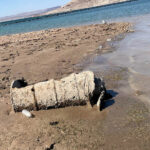
DL1961 introduces jeans made with 30% recycled content.
This month, denim brand DL1961 will show how old clothes and scraps can be turned into a new pair of jeans at the Frieze in London from May 5 to 22.
The New York-based brand is aiming to build the most eco-friendly denims through their family-owned business, says Sarah Ahmed, CEO and co-founder, which includes a factory in Pakistan that operates on renewable energy, recycles water, and opts for more eco-friendly dying techniques.
“At DL1961, sustainability and circularity are not defined by one initiative. They are multi-faceted, ever-evolving processes. We are one of the only vertical denim brands, overseeing the entire manufacturing process from fiber to finished garment. Instead of releasing sustainable capsules here and there, every single item we produce in our family-owned facility is 100% sustainable,” says Ahmed.
Unlike many brands that work with a manufacturer overseas, DL1961 is in a unique position: it’s an extension of the family’s denim manufacturing factory in Pakistan. That’s allowed the brand to be nimble and experiment with materials, dyes, and finishes a bit more easily, she admits.
Recommended For You
This spring, they’re bringing these innovations to an immersive exhibit called “Indigo” with Frieze at their London gallery on No. 9 Cork Street. “The concept is for people to experience the process of denim creation, from broken down fibers all the way to a finished denim garment.”
It starts at the recycling plant, which Ahmed notes is the “largest textile recycling plant in all of Asia,” and one that her family owns.
“We buy truckloads of post-consumer waste from all over the world so we can break down used plastic bottles, t-shirts, undies, and more, and turn them into new fibers.”
In addition to recycling the waste, they’ve partnered with Recover, a material sciences company that specializes in recycled fibers made from this so-called trash. Recover’s recycled cotton fiber, Ahmed argues, is markedly better for the environment than conventional cotton, and even organic cotton. To give jeans softness and better fit, the Recover fibers are combined with modal, tencel, and a small amount of elastane (for stretch), with Recover constituting about 30% of the fibers.
By using recycled materials, the company is able to avoid utilizing more water and dye, which are often the most impactful parts of the manufacturing process for denim. Ahmed says, “The average pair of jeans uses 1,500 gallons of water to produce. However, ours use less than 10 gallons because we use botanic fibers, organic and certified cotton, clean dyes, and energy-efficient laser and ozone technology.”
The goal is to give denim that worn-in, washed look but without using the traditional techniques. So Ahmed says they’ve not only reduced their water consumption by using lasers, for example, but they also treat and recycle 98% of the water used in their in-house water recycling plants.
The long-term goal is full circularity, and recycling is just a stepping stone towards it. Plus, the company is looking to launch The Digital Tag Project this year as well, which will be a QR code on each pair of jeans: it’ll quickly track and identify how much water, energy, and recycled materials were used in the process of making that particular jean.
Thus, while denim manufacturing has historically been a harmful process for the planet, Ahmed says, the hope is that it will not be in the near future as interest in sustainability grows. “Each day, more and more brands are committing to sustainability and circularity to lessen the industry’s environmental impact. I feel that as a result of the customer becoming a smarter shopper and more aware of where their clothes come from, the industry will continue to aim for innovative technologies, transparency, and meaningful sustainability practices to protect the integrity of our business, and ultimately the planet.”
In the meantime, DL1961’s exhibit in London gives consumers a window into how all their jeans could be made in the future.







